- Skip to main content
- Skip to after header navigation
- Skip to site footer

Our History
Empowering through health, wellness and historical knowledge

Multicultural London English: Evolution from cockney to a global linguistic mosaic

Multicultural London English (MLE) represents a dynamic and evolving dialect within London , reflective of the city’s rich cultural diversity. Originating from the traditional Cockney dialect, MLE has absorbed influences from Jamaican Patois and various African languages, evolving into a unique linguistic phenomenon.
Historical context and evolution
Cockney roots.
Cockney, traditionally associated with the working-class East End of London, is characterised by distinct phonetic features such as the dropping of ‘h’ sounds (h-dropping) and the glottal stop. For instance, the word “butter” would be pronounced as “bu’er.” Cockney rhyming slang, a playful use of metaphorical phrases, is another hallmark of this dialect. Historically, Cockney was a symbol of local identity and solidarity among the East Enders.
Post-war immigration and linguistic shifts
The aftermath of World War II marked the beginning of significant immigration to London from the Caribbean, Africa, South Asia, and beyond. This influx brought diverse linguistic influences, leading to the gradual transformation of Cockney. Jamaican Patois, brought by the Windrush generation from the Caribbean, played a crucial role in this linguistic evolution. The intermingling of these languages and dialects, combined with the traditional Cockney, laid the foundation for what would become MLE.
Linguistic features of MLE
Phonological characteristics.
MLE retains some phonetic elements of Cockney, such as the use of the glottal stop. However, it also incorporates features from other languages. For example:
- The ‘th’ sound in words like “thing” may be pronounced as ‘f’ (fing) or ‘v’ (muvver for mother), a feature common in both Cockney and Caribbean English.
- Vowel variations, where words like “face” and “goat” are pronounced with more centralised vowels, reflecting influence from various immigrant languages.
Lexical and grammatical innovations
MLE’s vocabulary is a rich tapestry of words from different cultures. Jamaican Patois has contributed terms like “bredren” (friend) and “mandem” (group of men). Additionally, words from West African languages, such as Yoruba and Twi, have found their way into MLE. This blend of lexical items creates a unique vernacular that is distinctly London.
Grammatically, MLE shows simplifications and innovations:
- Use of “man” as a pronoun, e.g., “Man’s not hot” instead of “I am not hot.”
- Variations in verb conjugation, where the standard English “is” and “are” might be replaced with “be,” reflecting the influence of Caribbean English.
Social implications and identity
Youth identity and group solidarity.
MLE is predominantly spoken by young people across various ethnic backgrounds in London. It serves as an identity marker, signalling belonging to a multicultural urban community. MLE is often seen as a way for youth to assert their cultural hybridity and reject traditional linguistic norms that may be perceived as exclusionary or representative of older, monolithic identities.
Media representation and perception
Media representation of MLE has been mixed, reflecting broader societal attitudes towards linguistic diversity. In popular culture, MLE is celebrated through music genres like grime and hip-hop, where artists like Stormzy and Skepta use the dialect to express their inner-city realities. However, there is also a tendency to stigmatise MLE, associating it with delinquency or a lack of education, echoing historical prejudices faced by speakers of Cockney and other non-standard dialects.
MLE in contemporary London
Education and mle.
The presence of MLE in schools highlights the ongoing debate about standard language instruction versus linguistic diversity. Teachers face the challenge of respecting students’ linguistic backgrounds while ensuring proficiency in Standard English. Initiatives promoting linguistic awareness and inclusivity aim to bridge this gap, recognising the value of MLE as part of London’s linguistic landscape.
Future trajectories
As London continues to be a hub of global migration, MLE is likely to evolve further, incorporating new linguistic influences. The dialect’s adaptability suggests it will remain a living testament to the city’s multicultural fabric. The future of MLE will be shaped by ongoing social changes, technological advancements, and continued cultural exchanges.
Multicultural London English is more than just a dialect; it is a reflection of London’s evolving cultural identity. From its roots in Cockney to the vibrant linguistic mosaic it is today, MLE encapsulates the dynamic interplay of languages in a globalised inner-city setting. Understanding MLE requires appreciating its historical development, linguistic features, and social significance. As London moves forward, MLE will undoubtedly continue to adapt and thrive, symbolising the city’s enduring diversity and resilience.
Key references include works by sociolinguists such as Paul Kerswill and Jenny Cheshire, who have extensively researched MLE’s development and characteristics.
- Kerswill, P., & Cheshire, J. (2013). “ Multicultural London English: The Emergence, Acquisition and Diffusion of a New Variety .” Journal of Sociolinguistics, 17(1), 1-29.
- Fox, S. (2015). “ The New Cockney: New Ethnicities and Adolescent Speech in the Traditional East End of London. ” Palgrave Macmillan.
- Rampton, B. (2017). “Language in Late Modernity: Interaction in an Urban School.” Cambridge University Press.
- Drummond, R. (2018). “ Researching Urban Youth Language and Identity.” Journal of Youth Studies , 21(7), 939-953.
Share this:
- Click to share on Facebook (Opens in new window)
- Click to share on Twitter (Opens in new window)
- Click to share on Reddit (Opens in new window)
- Click to share on Pinterest (Opens in new window)
- Click to share on WhatsApp (Opens in new window)
You May Also Like…

Cultural transformations in India: The abolition of historical practices

Jamaican culture: A vibrant tapestry of heritage and innovation

Emancipation Day: A celebration of freedom in the Caribbean

The essence of France: Exploring French values
Academia.edu no longer supports Internet Explorer.
To browse Academia.edu and the wider internet faster and more securely, please take a few seconds to upgrade your browser .
Enter the email address you signed up with and we'll email you a reset link.
- We're Hiring!
- Help Center

Download Free PDF
(2018) BA Thesis: "Multicultural London English: a Sociolinguistic Insight into an Emergent ‘Hybrid’ Language Variety"

Related papers
London is Europe’s largest city, and over a third of the foreign-born population of the UK lives there, with inner London boroughs having some of the highest proportions. In this paper, we look at how this intense level of inter-ethnic contact has influenced styles of English variation and use. The discussion starts with the large-scale picture and moves to individual practice, reflecting on how the two relate to one another. Focusing on the sociolinguistic dynamics of two Asian-dominant ‘micro-ecologies’ (Tower Hamlets and Ealing), we address the central puzzle of sociolinguistics today: How to reconcile the fine, fleeting acts of agency we see constantly in the individual with the blindly uniform march of change that we see at the community level? Our analyses point to a complexity that calls for refinement rather than rejection of traditional urban sociolinguistic models.
Roczniki Humanistyczne
Peter Trudgill has suggested that a number of the processes involved in new-dialect formation may be of a widespread or universal type. Multicultural London English (MLE) is a new dialect that emerged in a different and more complex sociolinguistic situation than those considered previously, so it provides an opportunity to further consider the extent to which the processes are widespread or universal. I argue that the characteristic features of MLE emerged as a result of dialect mixture, including traditional London English, colonial and creole-influenced varieties of English, and many different interlanguage varieties of English. Some MLE features confirm the relevance of the levelling of minority forms, and perhaps also of simplification. There is also evidence of drift. Above all, their emergence confirms the importance of linguistic accommodation in face-to-face interactions. In this, as for so many sociolinguistic issues, Peter Trudgill was right!
Listening to the Past
Journal of Sociolinguistics, 2011
A critical assessment of the moral panic surrounding the emergence of multiethnolects in London.
Language and Communication, 2011
Alea: Estudos Neolatinos, 2024
Estes fragmentos dialogam com a obra de raúl rodríguez freire, especialmente com seus livros La condición intelectual. Informe para una academia (Santiago de Chile, Mimesis, 2018); La universidad sin atributos (Santiago de Chile, Macul, 2020); La forma como ensayo. Crítica ficción teoría (Adrogué, La Cebra, 2020); Ficciones de la ley (Santiago de Chile, Mimesis, 2022) e La naturaleza de las humanidades. Para una vida bajo otro clima (Ed. raúl rodríguez freire, Santiago de Chile, Mimesis, 2022).
Réjouissances et déviances en temps de foire. Actes de la 6e journée d'étude du Centre de recherche sur le commerce international médiéval (CRECIM), 2024
Cet article s’intéresse à la question des foires et marchés comme lieux de la criminalité mais aussi comme lieux de justice dans l’espace bourguignon à la fin du Moyen Âge. Les sources disponibles pour ce genre d’étude sont multiples, des enquêtes et procès aux lettres de rémission en passant par les registres de délibérations et autres comptabilités. En se fondant dans un premier temps sur les lettres de rémission des ducs et duchesses de Bourgogne et sur les enquêtes et procès instruits par la mairie de Dijon, plusieurs éléments relatifs à la nature des crimes commis se dégagent. Le marché, entendu au sens de place dans la ville, figure parmi les lieux publics dans lesquels se déclenchent les rixes, souvent précédées d’échanges d’injures, la fréquentation de ces places renforçant le caractère diffamatoire de ces dernières. Les vols poursuivis dans le cadre des foires et marchés témoignent quant à eux des difficultés du temps d’après les quelques cas analysés. Les liasses d’enquêtes montrent en revanche que la mairie de Dijon poursuit régulièrement les personnes suspectées d’avoir acheté des denrées hors des marchés, car celles-ci échappant aux taxes elles constituent alors un manque à gagner pour les caisses ducales. La seconde partie est consacrée à une étude de cas portant sur un individu bien documenté, Symonnot Roillevault, boulanger dijonnais dont les démêlés avec la justice témoignent de la manière dont cet homme devenu officier de la mairie use et abuse de ses prérogatives pour favoriser ses propres intérêts économiques. Enfin, la dernière partie porte sur le marché comme lieu de justice dans l’espace bourguignon méridional, particulièrement en raison de la présence du pilori sur certaines de ces places comme en témoignent les comptabilités des bailliages des duché et comté de Bourgogne. Cette documentation permet d’approcher le lieu de justice dans sa matérialité voire dans sa monumentalité, tandis que des mandements de paiements témoignent du rituel d’exposition du condamné qui doit notamment porter une mitre figurant le crime qu’il a commis.
Dydaktyka Polonistyczna, 2019
Scottish Language, 2023
Organizational culture , 2021
Limite. Revista de estudios portugueses y de la lusofonía, 2023
Semata Ciencias Sociais E Humanidades, 2012
Journal of Quantitative Spectroscopy and Radiative Transfer, 1993
Πρακτικά 1ου Πανελλήνιου Συνέδριου ‘Προγράμματα σπουδών – Σχολικά εγχειρίδια: Από το παρελθόν στο παρόν και το μέλλον’, ΕΚΕΔΙΣΥ, Παιδαγωγική Εταιρεία Ελλάδας και Pierce-Αμερικάνικο Κολλέγιο Ελλάδας, 4-6 Μαρτίου 2016, Αθήνα , 2016
Production Planning & Control, 2012
Caderno Crh, 2011
THE PROCEEDINGS OF THE 4TH EPI INTERNATIONAL CONFERENCE ON SCIENCE AND ENGINEERING (EICSE) 2020
Genes, 2018
arXiv (Cornell University), 2018
Ethnobotany research and applications, 2024
Microbes and Infection, 2005
Pravo i privreda (Law and Economy), 2024
Physical review applied, 2018
Related topics
- We're Hiring!
- Help Center
- Find new research papers in:
- Health Sciences
- Earth Sciences
- Cognitive Science
- Mathematics
- Computer Science
- Academia ©2024
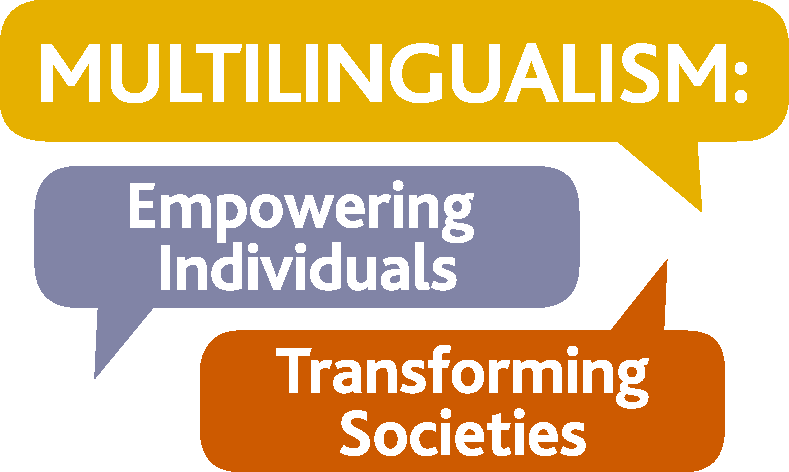
- Project Aims
- Research Questions
- Project Strands
- Project Team
- Research Associates
- Research Assistants
- PhD Students
- HE Partners
- Non-HE Partners
- Flexible Funding Projects
- Project Advisory
Policy Papers
Research lab papers, opinion articles, editorial team, editorial guidelines.
- Language Tasters
- For Researchers
- Policy Documents
- General Interest
- Useful Links

Multicultural London English and social and educational policies
21 may 2017, david adger, jenny cheshire, the emergence of multicultural london english (mle).
Two large-scale sociolinguistic projects carried out in London between 2004 and 2010 (Kerswill et al. 2004–2007, Kerswill et al. 2007–2010) analysed language use in Hackney, an area in the East End of London traditionally associated with the dense social networks of working class white Cockneys. Although there had been some immigrant arrivals to the area in the first half of the twentieth century (mainly Jewish people from different European countries and people from Ireland), in general Cockneys had rarely come into contact with speakers of other languages. However, during the post-war slum clearance and reconstruction of London many of the original inhabitants of the East End were transferred to new housing estates further east or to new towns in Essex (Fox 2015). This relocation left an ageing population in Hackney until, with the arrival of foreign immigrants, the population started to increase. The earliest immigrants to arrive were from the West Indies, but they were soon joined by immigrants from a very wide range of countries.
At first, immigrant groups were isolated from the indigenous community, which was not always welcoming. The children tended to keep the language of the home and the language of the school separate, and mainly did not acquire English until they attended school, where the English that they heard was the local London vernacular. Research carried out in London in the 1980s (Sebba 1993) found that Afro-Caribbean adolescents at that time were bidialectal, switching between Jamaican Creole and London English. ‘Anglo’ adolescents (children of the indigenous white working class Cockney families) sometimes used Creole words but they maintained the London Cockney English spoken at home.
By the late 1990s, when the adolescents who participated in the London research projects were growing up, the linguistic ecology of the area had changed. Hackney was becoming increasingly multilingual, and residential segregation was much less common. Today the area is multicultural, home to many different minority ethnic groups. In 2000, Baker and Eversley recorded 26 different languages spoken as a first language by schoolchildren in Hackney, a figure that underestimates the linguistic diversity of the area since it does not take account of the Creole languages spoken by immigrants from the Caribbean and from several African countries. The 2011 ONS (Office of National Statistics) survey recorded 88 different languages as spoken in Hackney. White British people now make up only about a third of the total population of the area (36.2% according to the 2011 ONS Census).
This linguistic diversity means that the local London vernacular is no longer the main English variety that children encounter at school. From a very young age, friendship groups are typically multiethnic: for example, the friendship groups in the Hackney projects, including for 5 year olds, included young people with parents from the Caribbean, several different African countries, Bangladesh, India, Morocco, China, Colombia, Portugal, Albania, Turkey and the Middle East, as well as from local Cockney families. The English spoken by children from such diverse backgrounds is very varied. The parents of some children are learning English and, although they may speak English at home, have various levels of proficiency and various kinds of language transfer from their first languages. Other children are from homes where English is spoken, often alongside other languages, but the English of the home may encompass different postcolonial varieties such as Indian English, Nigerian English or Ghanaian English, or a Creole-influenced variety. Children from homes where English is not spoken acquire English from a very young age from older siblings or from their peers at nursery school, but since ‘Anglo’ speakers of the indigenous London Cockney variety are in a minority, local models of English are less available for them than for previous generations. Thus, the English that children hear from each other is very varied. This means that there is no single clear target variety of English for children; instead, there is an extremely varied set of features of English, which can be likened to a ‘feature pool’ (Mufwene 2001) from which children select different combinations as they interact with each other. Of course, Anglo children are also exposed to the feature pool and the immense linguistic variation in their friendship groups. The English that emerges in this context is naturally very variable and norms are flexible: what is important above all is to communicate with each other.
As the children grow older, their English stabilizes. The result is Multicultural London English: a new variety of English that remains quite variable but that contains a core of innovative phonetic, grammatical and discourse features. Although our focus here is on London, similar developments are reported in other cities in the UK (Manchester, for example; see Drummond 2016, who introduces the term Multicultural Urban British English) as well as for other languages spoken in multilingual cities elsewhere in Europe and beyond.
";}s:16:“JI8FubO8VTMy0yFF”;a:3:{s:12:"element_type";s:6:"wygwam";s:16:"element_settings";s:204:"YToyOntzOjQ6InR5cGUiO3M6Njoid3lnd2FtIjtzOjg6InNldHRpbmdzIjthOjQ6e3M6NjoiY29uZmlnIjtzOjE6IjIiO3M6NToiZGVmZXIiO3M6MToibiI7czozOiJlaWQiO3M6MTY6IkVQWHdQZGZTVmdOOGRGR3ciO3M6NToidGl0bGUiO3M6NjoiV3lnd2FtIjt9fQ==";s:4:"data";s:5520:"
Linguistic characteristics of MLE
For linguists, the emergence of multiethnolects is an intriguing and exciting development. The rapid development of a set of innovative features means that we can observe language change at first hand rather than having to compare present day usage with documents from hundreds of years ago. It is relatively rare, for example, for new pronouns to emerge in a language and, when they do, it can take many years for them to become established. Pronouns are words referring to the speaker and the interlocutor (so, I or you ) or to people or things previously mentioned (e.g. he , she , it , they ). In MLE, man has recently emerged as a new pronoun, used for a range of rhetorical functions such as giving more communicative force to the expression of a personal opinion and having a range of specific grammatical functions. In (1), for example, the speaker explains that personality is more important than appearance when it comes to choosing a girlfriend: here the pronoun man takes on the same kind of grammatical function as the pronoun I.
(1) I don’t care what my girl looks like it’s her personality man’s looking at
Another new grammatical form is this is +speaker. This is a quotative expression (a form such as say or be like that introduces direct reported speech) which is used at key dramatic points of narratives, as in
(2) this is my mum’s boyfriend “put that in your pocket now”.
Such innovations reveal the kinds of communicative strategies that drive language change. The two features just mentioned, for example, allow speakers to give pragmatic force to key aspects of their discourse.
Other innovations are not completely new forms but instead result from young people using existing features of English to accomplish important discourse functions. For instance, unlike many other languages, English does not have special particles that emphasize specific parts of an utterance and that therefore allow speakers to indicate what is especially important. Bengali, in contrast, uses the particles je, to, naki and ki to indicate that a phrase is the topic of a clause (what the clause is to ‘be about’); and in Jamaican Creole the particle a emphasizes a following noun or adjective. Young speakers in London have filled this gap by using existing English forms in new ways. For example, research has shown that elsewhere in the UK the relative pronoun who is gradually being replaced by that (e.g. she’s the woman who/that bought my house ;. In MLE, however, who is not only alive and well but has acquired the function of indicating that the preceding noun is likely to be the main topic of conversation in the next few clauses. Innit , a very frequent new discourse marker in young people’s spoken English generally, has also acquired a special discourse function in MLE. Young people in Hackney use innit with the same frequency as young people in Havering, an outer London area with very little linguistic diversity (one of the areas, in fact, to which Cockney families were relocated postwar); but in Hackney it has a unique discourse function of indicating that the preceding noun refers to an important item that will be developed in what comes next (e.g. a speaker who utters the girl innit makes it clear that she intends to tell a story about something the girl in question did).
There are innovations in accent too. Phonetic innovations include the backing of /k/ before low back vowels to [q] and changes to the long vowel system, including a narrow diphthong or monophthong for the lexical set of FACE ([eɪ] or [e] in place of Cockney [æɪ]); this means that a word such as face sounds more like ‘fes’ than RP ‘fays’ or Cockney ‘fayis’. Samples of MLE can be heard on http://linguistics.sllf.qmul.ac.uk/linguistics/english-language-teaching/ The region is traditionally h-dropping, with a word like head pronounced without the intial /h/; young MLE speakers however, pronounce initial /h/ to an extent greater than in other South Eastern English varieties. There is a more syllable-timed (staccato) rhythm and while standard English has two forms, a and an, for indefinite articles, MLE tends to use only a : a is heard not only before consonants, as in a banana , but also before a following vowel, as in a apple . Innovations in vocabulary are mainly borrowings from Jamaican English, illustrating the well-known (in linguistics) Founder Principle, a term borrowed from population genetics (Mufwene 2001): the vocabulary of the linguistic founding population in an area continues to survive despite the arrival of later, different, immigrant groups. They include blood and bredren (‘friend’), cuss (‘defame’), ends (‘estate’ or ‘neighbourhood’), tief (‘steal’) and whagwan (‘what’s up’).
”;}s:16:“w4S4S0PhMDDpKPnK”;a:3:{s:12:"element_type";s:6:"wygwam";s:16:"element_settings";s:204:"YToyOntzOjQ6InR5cGUiO3M6Njoid3lnd2FtIjtzOjg6InNldHRpbmdzIjthOjQ6e3M6NjoiY29uZmlnIjtzOjE6IjIiO3M6NToiZGVmZXIiO3M6MToibiI7czozOiJlaWQiO3M6MTY6IkVQWHdQZGZTVmdOOGRGR3ciO3M6NToidGl0bGUiO3M6NjoiV3lnd2FtIjt9fQ==";s:4:"data";s:4192:"
Attitudes to MLE
Kerswill (2014) describes responses to MLE in the media, where it has been referred to as ‘Jafaican’, a term that encapsulates lay perceptions that ‘it sounds black’. Journalists are presumably influenced by the recognisably Jamaican English vocabulary, and perhaps also by the characteristic MLE vowels: the MLE pronunciation of words such as face and goat is similar to their pronunciation in the English of the Caribbean and in parts of West Africa. However, these pronunciations are also typical of the English of the Indian subcontinent and other postcolonial varieties, as well as that of many learner varieties of English. The same is true of the tendency to use a and unstressed the before nouns beginning with a vowel as well as before nouns beginning with a consonant. It is the frequency of forms such as these in the feature pool that results in the typical MLE pronunciations, and that the forms stem from a diverse set of linguistic sources rather than from any single language. Other innovations in MLE reflect universal tendencies in language generally (such as the marking of discourse prominence, mentioned above). Certainly the young people who participated in the MLE projects did not associate their way of speaking with ‘talking black’; if pressed, they either said that their language was ‘normal’ or that they spoke ‘slang’, referring to the characteristic vocabulary. Like most speakers of English, they were generally unaware of the phonetic, grammatical and discourse-pragmatic features of their grammar.
The sociolinguists’ term ‘multiethnolect’, then, reflects the fact that MLE (and similar varieties elsewhere) is spoken by young people from all ethnic groups living in the multilingual inner city area, including the ‘Anglos’ from indigenous Cockney families. It should be welcomed as a socially inclusive new variety. It fully reflects the findings of a recent survey carried out by Hackney Local Authority, which reported that 89% of Hackney’s residents find Hackney to be a place where people from different backgrounds get on well together and that Hackney’s diversity and multiculturalism are the main factors contributing to residents feeling proud of Hackney. The Local Authority (London Borough of Hackney Policy Team 2016: 14) explain that
In part this is a result of Hackney’s long history of immigration and welcoming people into the borough which has resulted in local neighbourhoods that are very diverse where people have an opportunity to mix and meet people from different religious and ethnic backgrounds. Many people also have personal or family experience of migration and are welcoming to new arrivals.
Yet rather than rejoicing in the emergence of a socially inclusive way of speaking, a wide range of authority figures, particularly in education, among members of Parliament, and in some sections of the print and televisual media, have condemned it (see Kerswill 2014). Kerswill refers to comments made by David Starkey, a medieval historian and successful television history presenter, during a live discussion on BBC TV’s Newsnight . Starkey made an explicit link between this type of language, violence and black culture, and stated that white people had bought into it, becoming ‘black’ in the process.
There is a longstanding divide in attitudes towards linguistic diversity between speakers of non-standard dialects, linguists who have studied these dialects, and the media and influential authority figures. However, in the case of MLE the divide risks becoming racialized. If MLE, and multethnolects more generally, are stigmatized and poorly understood, there is also the risk of increasing still further the gap in the educational achievement of young speakers of non-standard dialects and young people who grow up speaking standard English at home, as well as increasing the possibilities of unwitting social discrimination on a wider scale.
";}s:16:“b7oB0a3XIW7GNfDx”;a:3:{s:12:"element_type";s:6:"wygwam";s:16:"element_settings";s:204:"YToyOntzOjQ6InR5cGUiO3M6Njoid3lnd2FtIjtzOjg6InNldHRpbmdzIjthOjQ6e3M6NjoiY29uZmlnIjtzOjE6IjIiO3M6NToiZGVmZXIiO3M6MToibiI7czozOiJlaWQiO3M6MTY6IkVQWHdQZGZTVmdOOGRGR3ciO3M6NToidGl0bGUiO3M6NjoiV3lnd2FtIjt9fQ==";s:4:"data";s:8157:"
Implications for educational practice and policy
Some aspects of educational policy in England and Wales deal positively with linguistic diversity. The General Certificate of Education (GCE) Advanced level syllabus for English Language requires students to show how a wide range of linguistic terminology can be accurately applied to a range of contexts for language use, including historical, geographical, social and individual varieties of English, and aspects of language and identity (Department for Education 2014b: 2). The English Language A level has proved popular in schools in multicultural urban areas, where the focus on sociolinguistic variation and identity appeals to students from minority ethnic backgrounds, since their own linguistic experiences are relevant, valued and analysed during their studies. It positions speakers of non-standard varieties to acquire standard English more effectively through learning about the social diversity of English. Teachers report that although higher grades are just as hard to gain as in other subjects, its relevance to everyday life and the opportunity for students to analyse their own language uses allows less able and average students to achieve as well as the most gifted (Bleiman and Webster 2006: 28). It therefore provides opportunities for social mobility and for improving the skills base of UK society, with significant benefits for both individuals and society. Furthermore, the subject is ‘boy-friendly’: 6% of all male and 8% of all female A level entries are for English Language, compared to, for example, 14% male and 26% female entries for A level English Literature. Boys prefer GCE A level English Language to other language subjects, giving them the opportunity to catch up with girls in the acquisition of language skills. For a brief period between 2010 and 2014 the General Certificate of Secondary education (GCSE) English Language and English Literature curriculum also included the study of variation in spoken English and its relation to identity and cultural diversity.
School teachers of A level English Language tend to be well informed about the nature of linguistic diversity in general and about dialects, including multiethnolects, in particular, attending workshops on the topic and making good use in the classroom of resources developed by linguists (Cheshire and Fox 2016). Other educationists, however, have reacted negatively to the new ways of speaking. Kerswill (2014) discusses the 2008 ban by a secondary school in Manchester on the use of ‘slang’ anywhere on the school premises. The language that was objected to was contemporary British youth slang, some of which was Jamaican in origin and typical of MLE. In London, the use of words associated with urban youth dialects was forbidden at the Harris Academy of Upper Norwood, as a way of preparing pupils for their future on the labour market and in mainstream British society.
It is understandable that head teachers and others are concerned about the social prospects of young speakers of a variety that is stigmatized. The aim of the National Curriculum guidance that students should be taught to use standard English ‘when the context and audience requires it’ presumably has the goal of social equality in mind. But a blanket ban goes against this guidance and is not the way to promote linguistic and social equality. People change their way of speaking only to the extent that they are motivated to do so; and it has long been known that negative motivations result in an increased use of non-standard linguistic forms from young people who in fact have the ability to change their way of speaking (see Cheshire 1982 for an early empirical study of pupils’ unconscious use of standard and non-standard English forms at school). We do not yet know the extent to which speakers of MLE adjust their way of speaking in different situations, though research at Queen Mary University of London is currently investigating this. In Manchester young speakers of the local multiethnolect adapt their language use when taking part in mock job interviews (Rob Drummond, personal communication), and a great deal of research shows that speakers of nonstandard dialects shift towards standard English in situations where they see it as appropriate to do so, for example in role plays or when called on to speak with authority to the class. A realistic educational policy would aim to increase students’ exposure to standard English and ensure that the exposure is a positive experience, and to ensure that students are given opportunities to adopt an authoritative footing in the classroom, while not discouraging them from using non-standard English in appropriate contexts.
Multiethnolects such as MLE have emerged in city areas with limited financial resources. In 2010 Hackney ranked second in the country on the Index of Multiple Deprivation. The situation has improved with the post-Olympic focus on the East End as an area of growth and development; nevertheless, the figures from the End Child Poverty Campaign show Hackney as having the second highest rate in the country for child poverty in 2015 (London Borough of Hackney Policy Team 2016: 19). A background of high deprivation combined with negatively assessed language creates difficulties in expanding social and employment networks, but attempting to impose standard English will not help. Rather, students need to be taught about language variation and about using language appropriately, and this means understanding their own language, as well as standard English. We would recommend a policy that embeds an understanding of non-standard varieties throughout the school curriculum, from primary school onwards.
It follows that there is a need for a clearer dialogue between linguists and schools, so that schools are well informed about the properties of local linguistic varieties, and their relation to standard English. A concrete policy suggestion is to commission the production of descriptions of urban multiethnolects, explaining why they are consistent linguistic systems, how they differ from standard English, and how issues of style and register impact on the use of the different varieties, along with guidance for teachers in the local area. This would facilitate understanding between teachers and students and might allow teachers on occasion to sensitively guide students in ‘code-switching’ between non-standard and standard forms. Students themselves, as they grow older, can be engaged in this descriptive linguistic work, which has social, educational and linguistic benefits. Of course, it is not only descriptions of multiethnolects that would be useful: ideally, descriptions of the local dialect would be available for all school teachers in all areas of the country.
A further policy suggestion is to commission research that compares the linguistic situation in the UK with that in comparator countries around the world. We agree with Snell and Andrews’ view (2016) that there is much to learn from common problems that are faced globally. The more the world moves to three or four world languages (English, Mandarin Chinese, Spanish and possibly Arabic), the more the relationship between local dialect, national languages and world languages will become critical to personal and social/economic advancement. We further recommend commissioning research to evaluate the effectiveness of the many initiatives designed to promote use of the standard variety in different European countries (Cheshire et al. 1989), few of which yet to be formally assessed.
Outside education, institutions working towards policies that promote social equality and diversity should be encouraged to include language. Awareness of linguistic diversity and avoidance of unconscious discrimation on the basis of language is as important for social equality as awareness of the potential effects of gender, race, disability, religion or sexual orientation.
";}s:16:“MTJav71Id3fhHIdv”;a:3:{s:12:"element_type";s:6:"wygwam";s:16:"element_settings";s:204:"YToyOntzOjQ6InR5cGUiO3M6Njoid3lnd2FtIjtzOjg6InNldHRpbmdzIjthOjQ6e3M6NjoiY29uZmlnIjtzOjE6IjIiO3M6NToiZGVmZXIiO3M6MToibiI7czozOiJlaWQiO3M6MTY6IkVQWHdQZGZTVmdOOGRGR3ciO3M6NToidGl0bGUiO3M6NjoiV3lnd2FtIjt9fQ==";s:4:"data";s:425:"
Acknowledgments
The research leading to these results has received funding from the European Union’s Seventh Framework Programme for research, technological development and demonstration under grant agreement no 613465, and from the UK Economic and Social Research Council (projects RES 000 23 0680, RES 062 23 0814 and RES -189-25-0181).
";}s:16:“8vkuLQ4mCt9EAzD1”;a:3:{s:12:"element_type";s:6:"wygwam";s:16:"element_settings";s:204:"YToyOntzOjQ6InR5cGUiO3M6Njoid3lnd2FtIjtzOjg6InNldHRpbmdzIjthOjQ6e3M6NjoiY29uZmlnIjtzOjE6IjIiO3M6NToiZGVmZXIiO3M6MToibiI7czozOiJlaWQiO3M6MTY6IkVQWHdQZGZTVmdOOGRGR3ciO3M6NToidGl0bGUiO3M6NjoiV3lnd2FtIjt9fQ==";s:4:"data";s:1913:"
A databank containing recordings of MLE speakers, together with transcripts of the recordings, are at http://linguistics.sllf.qmul.ac.uk/linguistics/english-language-teaching/
A general overview of the MLE research is in Cheshire, Jenny, Paul Kerswill, Susan Fox and Eivind Torgersen, 2011, ‘Language contact and language change in the multicultural metropolis’, Revue Française de Linguistique Appliquée 18: 63-76; available at http://jennycheshire.com/publications
Short (500 word) summaries of different aspects of the MLE research are at:
http://linguistics-research-digest.blogspot.co.uk/2011/11/multicultural-london-english-part-1.html
http://linguistics-research-digest.blogspot.co.uk/2011/12/multicultural-london-english-part-2.html
http://linguistics-research-digest.blogspot.co.uk/2011/12/multicultural-london-english-part-3.html
http://linguistics-research-digest.blogspot.co.uk/2011/12/multicultural-london-english-part-4.html
http://linguistics-research-digest.blogspot.co.uk/2014/03/its-her-personality-mans-looking-at.html
”;}s:16:“QbfFkaUUf7l5GzF6”;a:3:{s:12:"element_type";s:6:"wygwam";s:16:"element_settings";s:204:"YToyOntzOjQ6InR5cGUiO3M6Njoid3lnd2FtIjtzOjg6InNldHRpbmdzIjthOjQ6e3M6NjoiY29uZmlnIjtzOjE6IjIiO3M6NToiZGVmZXIiO3M6MToibiI7czozOiJlaWQiO3M6MTY6IkVQWHdQZGZTVmdOOGRGR3ciO3M6NToidGl0bGUiO3M6NjoiV3lnd2FtIjt9fQ==";s:4:"data";s:4301:"
Further reading
Baker, Philip and John Eversley. 2000. Multilingual Capital (London: Battlebridge Publications)
Bleiman, Barbara and Lucy Webster. 2006. English at A level: A guide for Lecturers in Higher Education. A Report to the Higher Education Academy English Subject Centre (London: English and Media Centre Report Series no. 12)
Cheshire, Jenny. 1982. ‘Dialect features and linguistic conflict in schools’, Educational Review, 34.1: 53-67
Cheshire, Jenny, Viv Edwards, Henk Münstermann and Bert Weltens (eds.). 1989. Dialect and Education: Some European Perspectives (Clevedon: Multilingual Matters).
Cheshire, Jenny and Susan Fox. 2016. ‘From sociolinguistic research to English Language Teaching’, in Creating and digitizing language corpora. Vol. 3. Databases for public engagement, ed. by Karen P. Corrigan & Adam Mearns (Basingstoke: Palgrave Macmillan), pp. 265-290. Available on www.jennycheshire.com/publications
Department for Education 2014a Statutory Guidance. National Curriculum in England: English Programmes of Study , < https://www.gov.uk/government/publications/national-curriculum-in-england-english-programmes-of-study/national-curriculum-in-england-english-programmes-of-study > [accessed 21 February 2017]
Department for Education. 2014b. GCE AS and A level subject content for English language . London: Department for Education, DFE-00362-2014, < https://www.gov.uk/government/uploads/system/uploads/attachment_data/file/302109/A_level_English_language_subject_content.pdf > [accessed 9 June 2015]
Drummond, Rob. 2016. ‘(Mis)interpreting urban youth language: white kids sounding black?’, Journal of Youth Studies , 20. 5: 640-660
Fox, Susan. 2015. The New Cockney (Basingstoke: Palgrave Macmillan)
Kerswill, Paul. 2014. ‘The objectification of ‘Jafaican’: the discoursal embedding of Multicultural London English in the British media’, in The Media and Sociolinguistic Change, ed. by Jannis Androutsopoulos (Berlin: De Gruyter), pp. 428-455
Kerswill, Paul, Jenny Cheshire, Susan Fox and Eivind Torgersen. 2004-2007. Linguistic Innovators: The English of Adolescents in London (UK Economic and Social Research Council project RES 000 23 0680)
Kerswill, Paul, Jenny Cheshire, Susan Fox and Eivind Torgersen. 2007-2010. Multicultural London English (UK Economic and Social Research Council project RES 062 23 0814)
London Borough of Hackney Policy Team. 2016. A profile of Hackney, its people and place , < https://www.hackney.gov.uk/Assets/Documents/Hackney-Profile.pdf > [accessed 19 February 2017]
Mufwene, Salikoko. 2001. The Ecology of Language Evolution (Cambridge: Cambridge University Press)
Sebba, Mark. 1993. London Jamaican (London: Longman)
Snell, Julia and Richard Andrews. 2016. ‘To what extent does a regional dialect and accent impact on the development of reading and writing skills?’ Cambridge Journal of Education < http://dx.doi.org/10.1080/0305764X.2016.1159660 >
Please cite: Cheshire, J., Hall D., & Adger, D. (2017). Multicultural London English and social and educational policies. Languages, Society & Policy https://doi.org/10.17863/CAM.9804
About the author
Jenny Cheshire is Professor of Linguistics at Queen Mary University of London
David Hall is Postdoctoral Research Assistant on AThEME: The Emergence of Multiethnic Varieties at Queen Mary University of London
David Adger is Professor of Linguistics at Queen Mary University of London
Related Strand
Strand 2: standard languages, norms and variation: comparative perspectives in multilingual contexts, strand 3: sociolinguistic perspectives on multilingualism: identity, diversity and social cohesion, related policy papers, can global cities have a language policy.
by Yaron Matras
Multilingual education for multilingual speakers
by Ianthi Maria Tsimpli
Healthy linguistic diet: the value of linguistic diversity and language learning across the lifespan
by Dina Mehmedbegovic Thomas H Bak
Related Dialogues
Find by author, contact the journal.

Our Partners

Contact Details
If you would like to receive news and updates on the project’s activities, please contact:
- 01223 760356
- [email protected]
- Multilingualism: Empowering Individuals, Transforming Societies (MEITS) 17 Mill Lane, Cambridge, CB2 1RX
A flagship AHRC-funded project to revitalize Modern Languages and shape UK language policy by showing how multilingualism can empower individuals and transform societies.
- OWRI Intranet
Keep yourself up to date!
We will never send spam and you can unsubscribe any time. See our Privacy Policy
Copyright © 2016-2024 MEITS
- Craft and Criticism
- Fiction and Poetry
- News and Culture
- Lit Hub Radio
- Reading Lists

- Literary Criticism
- Craft and Advice
- In Conversation
- On Translation
- Short Story
- From the Novel
- Bookstores and Libraries
- Film and TV
- Art and Photography
- Freeman’s
- The Virtual Book Channel
- The Lit Hub Podcast
- The Critic and Her Publics
- Fiction/Non/Fiction
- I’m a Writer But
- Windham-Campbell Prizes Podcast
- Write-minded
- First Draft: A Dialogue on Writing
- Behind the Mic
- Lit Century
- Tor Presents: Voyage Into Genre
- Beyond the Page
- The Cosmic Library
- Emergence Magazine
- The History of Literature
- The Best of the Decade
- Best Reviewed Books
- BookMarks Daily Giveaway
- The Daily Thrill
- CrimeReads Daily Giveaway

Multicultural London: A Reading List of Displacement, Diaspora, and Diversity
Cecile pin recommends zadie smith, xiaolu guo, and more.
London is one of the most multicultural cities in the world. As of 2021, 41% of Londoners were born outside the United Kingdom. Looking at the city’s vibrant diasporas offers a window into the United Kingdom’s history, both dark and good. Whether through its colonial past, the Windrush Generation, or its time in the European Union, London is a city that has been repeatedly marked by movement—and made all the better for it.
My novel Wandering Souls follows three siblings—Anh, Thanh and Minh—as they leave Vietnam after the war, losing their parents and four younger siblings on the perilous journey. After spending time at a refugee camp in Hong Kong, they settle in Margaret Thatcher’s Britain: a period of great political and societal upheaval. There, they must learn how to build new lives for themselves, while also grieving immeasurable loss.
Below is a list of other novels that deal with displacement in London, which I love and have inspired me.

White Teeth by Zadie Smith
Let’s begin with a modern classic of multicultural Britain, White Teeth . In many ways, its main character is a place: Willesden in North London. Through Willesden, Smith explores three families whose lives intertwine over the course of four generations. Smith’s Willesden is a microcosm of late-20 th Century Britain; a place where increasingly plural identities love, laugh, dance, become Jehovah’s Witnesses, and genetically engineer mice. It’s a wild, riotous novel powered along by its truly unforgettable cast.
White Teeth was a trailblazer; a slew of books about London, Britain and migration followed in its wake. To read it today is like catching up with an old friend.
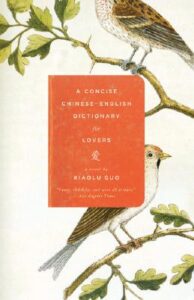
A Concise Chinese-English Dictionary for Lovers by Xiaolu Guo
Zhuang, a young Chinese woman, arrives in London to spend a year learning English. As she struggles to make the city, and the English language, her own, she falls head over heels for an older Englishman. She quickly moves in with him – and finds herself managing the even trickier terrains of love.
A Concise Chinese-English Dictionary for Lovers is a tender and clever tale, filled with humor. Above all, it is a novel about what it’s like to be a young woman, all the while feeling adrift and alien in a land that is not quite yours.

Home Fire by Kamila Shamsie
After years of caring for her younger twin siblings in London, Isma embarks on a journey to America to achieve her long-deferred academic ambitions. But she cannot stop worrying about her siblings. Aneeka, her headstrong sister, is studying Law; her brother Parvaiz has left their home in pursuit of their father’s legacy, once a jihadist.
Enters Eamonn, the son of a powerful British politician. As he filters through the sisters’ life and creates a rift, they are forced to question which is the strongest bond – blood or love.
A modern day retelling of Antigone, Home Fire explores what it means to be Muslim in Great-Britain, through a suspenseful and heart-breaking tale of a Pakistani-British family.
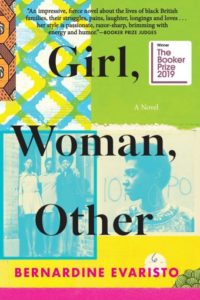
Girl, Woman, Other by Bernardine Evaristo
Winner of the Booker Prize, Girl, Woman, Other follows the lives of twelve characters – mostly women, mostly black – in Great-Britain. Almost all are either immigrants or children of immigrants, from Ghana, Nigeria, the Gambia, Barbados, Abyssinia, and Somalia. Besides London, we follow their lives in Cornwall and Newcastle throughout the last hundred years. We witness the discrimination they face, but also the joy they experience, the friendships they form.
Girl, Woman, Other is an ode to black womanhood and modern day Great-Britain. Like White Teeth , it is an ultimately joyous and triumphant tale, with an array of lovable characters.
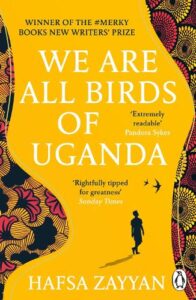
We Are All Birds of Uganda by Hafsa Zayyan
Sameer is a young, high-flying lawyer living in present-day London, who feels like something is missing from his life. He gets a lucrative job opportunity in Singapore, which he is tempted to accept. Before he does so, he goes on a trip to Uganda, where he uncovers his family’s past.
Intertwined with Sameer’s narration is that of his grandfather Hasan in 1960s Uganda. A family man struggling to keep his business afloat, Hasan’s life is forever changed when Idi Amin seizes power in Uganda, and orders the expulsion of his country’s Indian minority. Hasan is forced to leave his home, and his life behind, and settles in the United Kingdom.
We Are All Birds of Uganda shines a light on a dark page of Uganda’s history. It explores generational divides and racial tensions, and has huge resonance with today’s world.
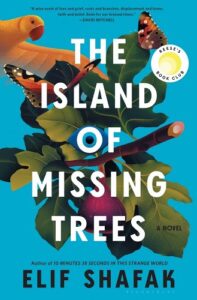
The Island of Missing Trees by Elif Shafak
On the then-divided island of Cyprus in the 1970s, two teenagers, one a Greek Cypriot the other a Turkish Cypriot, meet at a taverna on the island they both call home. There, a fig tree bears witness to their growing love, and their ultimate departure – war breaks out, and the capital is destroyed.
Years later, a Ficus tree grows in Ada’s back garden in London, the only connection she has to an island – and past – she knows little about. A troubled teenager, Ada is given a school assignment which leads her to untangle her family’s troubled history.
Dealing with war and its aftermaths, loss, love, and also the environment, The Island of Missing Trees is a wonderful tale about belonging and longing for a home you don’t know.
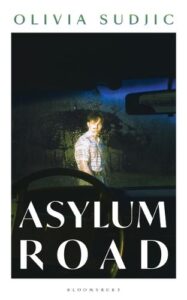
Asylum Road by Olivia Sudjic
During a holiday in coastal Provence, Luke proposes to Anya, and they return to London engaged. However, Anya feels uneasy – about their relationship and herself. She escaped war-torn Sarajevo as a young child, and when she goes back to visit her parents, suppressed memories rise to the surface.
Asylum Road will leave you on the edge of your seat. A powerful and unsettling work, we follow Anya as she tries to come to terms with her past, and the new life that awaits her.
__________________________________
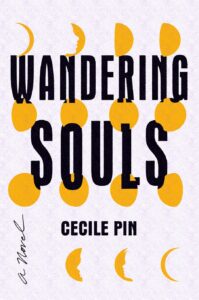
Wandering Souls by Cecile Pin is available from Henry Holt and Co., an imprint of Macmillan, Inc.
- Share on Facebook (Opens in new window)
- Click to share on Twitter (Opens in new window)
- Click to share on Google+ (Opens in new window)
- Click to share on LinkedIn (Opens in new window)
- Click to share on Reddit (Opens in new window)
- Click to share on Tumblr (Opens in new window)
- Click to share on Pinterest (Opens in new window)
- Click to share on Pocket (Opens in new window)

Previous Article
Next article, support lit hub..

Join our community of readers.
to the Lithub Daily
Popular posts.

Leopoldo Gout on the Living Dead Who Layer Mexico City
- RSS - Posts
Literary Hub
Created by Grove Atlantic and Electric Literature
Sign Up For Our Newsletters
How to Pitch Lit Hub
Advertisers: Contact Us
Privacy Policy
Support Lit Hub - Become A Member
Become a Lit Hub Supporting Member : Because Books Matter
For the past decade, Literary Hub has brought you the best of the book world for free—no paywall. But our future relies on you. In return for a donation, you’ll get an ad-free reading experience , exclusive editors’ picks, book giveaways, and our coveted Joan Didion Lit Hub tote bag . Most importantly, you’ll keep independent book coverage alive and thriving on the internet.

Become a member for as low as $5/month

IMAGES
VIDEO
COMMENTS
What is Multicultural London English (MLE)? If you’re a Londoner, or even if you’re not, have you noticed the way a lot of young Londoners speak, particularly in places like Hackney or Lewisham or other inner-city areas?
Multicultural London English (MLE) represents a dynamic and evolving dialect within London, reflective of the city’s rich cultural diversity. Originating from the traditional Cockney dialect, MLE has absorbed influences from Jamaican Patois and various African languages, evolving into a unique linguistic phenomenon.
Multicultural London English is socially inclusive in that it is spoken by people from all ethnic groups living in multilingual inner-city areas, including those from indigenous local Cockney families.
Multicultural London English (MLE) is a new dialect that emerged in a different and more complex sociolinguistic situation than those considered previously, so it provides an opportunity to further consider the extent to which the processes are widespread or universal.
The research presented here constitutes the first investigation of the standard language ideology (SLI) in Great Britain that takes account of a multiethnolect – namely Multicultural London English (MLE).
Though research on the multiethnolect spoken in London—Multicultural London English (MLE)—has described the social distribution of the variety, the stylistic potentials of MLE remain poorly understood.
As the children grow older, their English stabilizes. The result is Multicultural London English: a new variety of English that remains quite variable but that contains a core of innovative phonetic, grammatical and discourse features.
Multicultural London English and social and educational policies. by Jenny Cheshire, David Hall , David Adger . The linguistic diversity of the UK presents a longstanding challenge for social equality and social mobility.
London is one of the most multicultural cities in the world. As of 2021, 41% of Londoners were born outside the United Kingdom. Looking at the city’s vibrant diasporas offers a window into the United Kingdom’s history, both dark and good.
Data reveals that there is no significant geographic proximity effect on performance between US and British participants, and suggests that despite the varying heritages of young, ethnic minority speakers in London, they speak an innovative and emerging variety: Multicultural London English (MLE).